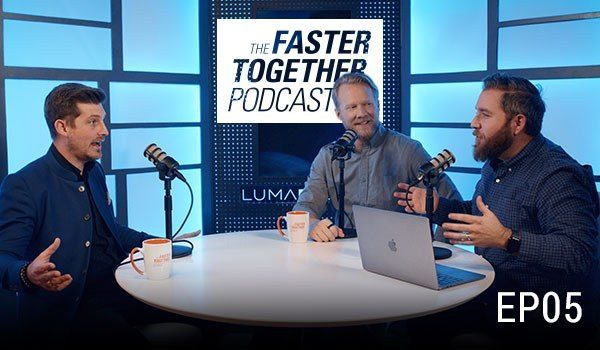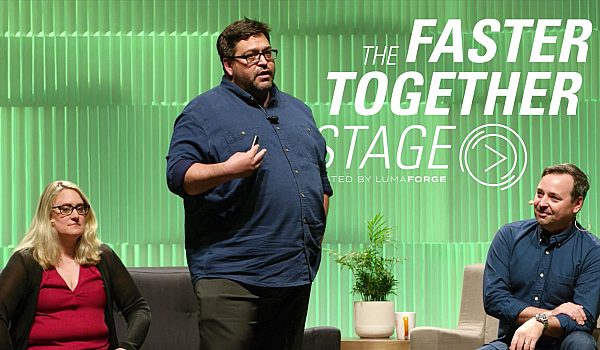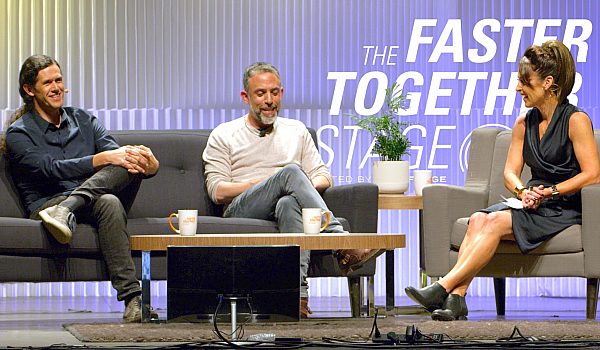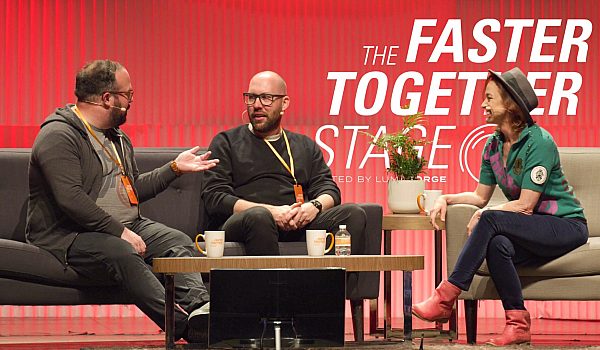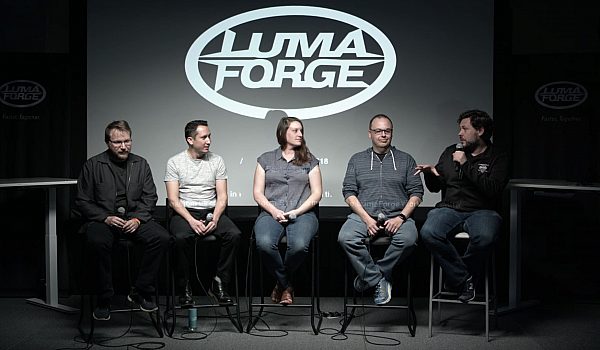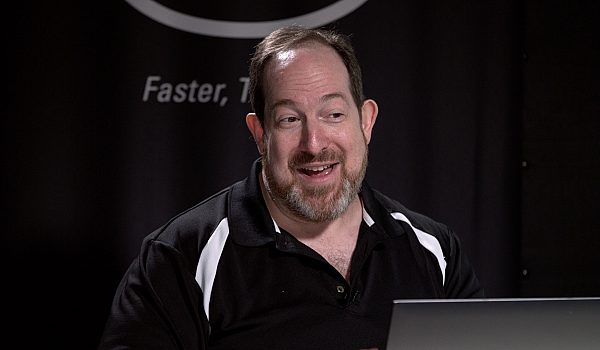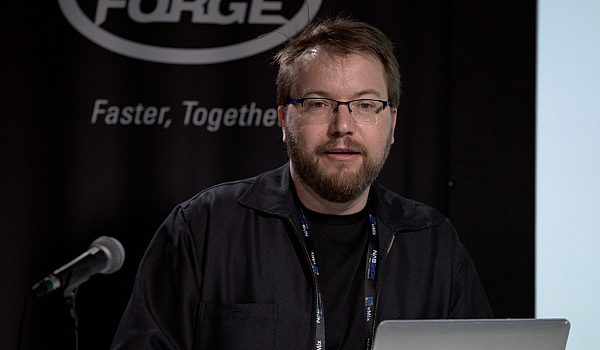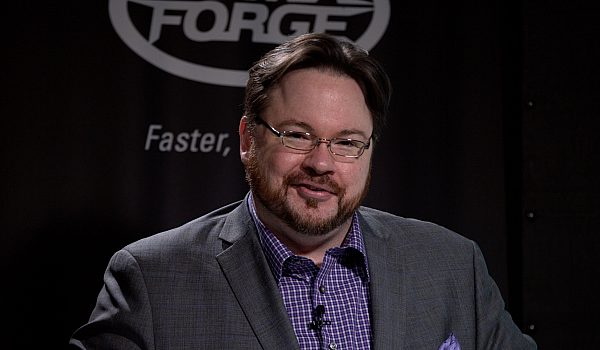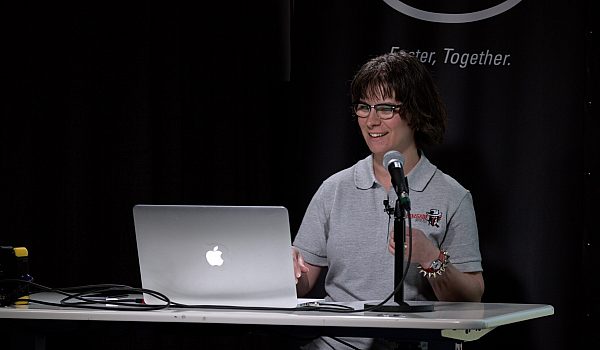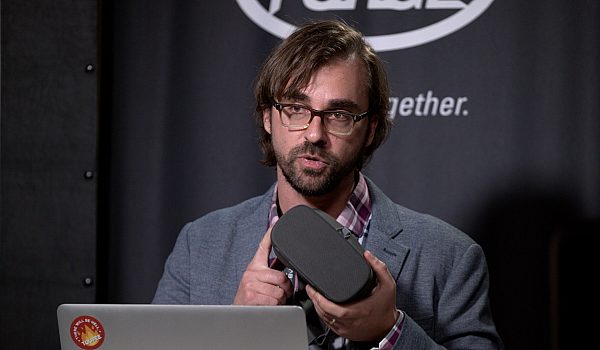Bill Davis, Michael Kammes, Oliver Peters and Scott Simmons take on one of the most controversial questions in post production. Which editing software is best?! They discuss the benefits and downsides to Premiere Pro, FCPX, Avid, and DaVinci Resolve. Find out which NLE will work best for your project.
Bill Davis: well, I think this was promoted originally as some kind of cage match and there will be no blood here today. We're all, we all known each other for a long time and there's a lot of respect here. Everybody has a point of view that is well established and we all try to look out and understand not just the pluses but the minuses of everything. So you're going to try, probably get a, a pretty good even plan and nobody's going to be trashing anybody, but we will try to eliminate some of the differences. So just you wait. Okay. So Michael [inaudible], tell him who you are.
Michael Kammes: Uh, my name is Michael Kammes. I'm the director of technology at key code media. Uh, I'm here not on behest of keycode media, but uh, coming with knowledge provided by them. Uh, we're an integrator, uh, in the Hollywood arena as well as around the country. So, uh, we play with a lot of NLS, especially avid Oliver. Uh, I'm all over Peter's. I'm a freelance editor and a colorist and primarily in the central Florida area. So commercials, corporate videos,
Scott Simons: the odd in new feature film, whatever comes our way. And you've seen his name in print a thousand times because Oliver has written a thousand articles. Scott, uh, Scott Simmons, I'm also a freelance editor out of Nashville and in a lot of the same stuff I'll ever works on and don't get many features but do a lot of music stuff. And I, uh, I have run the edited blog on, uh, on Provideo coalition where I'm the managing editor, P Provideo coalition.com. And um, so yeah, we talk about this stuff a lot, sadly. So who wants to go first and just pick an NLE or just do like maybe a very short overview of everything? Scott, you, you have the current Mike. Well, I mean, you know, the state of the NLE right now is very good. There's, we've never had so many choices. It's so many price points and uh, from ranging from several hundred bucks down to free, a lot of free options out there.
Scott Simons: It's not just avid Apple and delving, in fact, I did a class at NAB this year called NLE independence. At a team beyond avid, Apple and Adobe and, um, didn't realize, I mean you kind of what was out there, but digging into some of the other options, there's, there's a lot of stuff out there for pretty much any sort of way. One wants to work for the most part, but you know, they're still premiere, avid final cut. Now we've got resolved. It was all of a sudden got a lot better. But there's a, you know, the kids are using hit film, light works is still free and movies are being cut in Lightworks Sony has a little program called catalyst edit and then they sold Vegas to magics, which is in making, trying to make Vegas still a thing. So there's a, there's a lot. Absolutely.
Michael Kammes: Yeah. I, I kind of view it as a, you know, sort of the best of times, the worst of times, right? So if you're a user, uh, it couldn't be better. I mean, you know, compared to when we started in the business, the cost is an infant test on the mall amount versus studios and facilities of, of years past. But I think it's also a difficult time for developers because if you make plugins, it's kind of hard to sell an expensive plugin that costs more than the application.
Oliver Peters: So, um, you know, pros and cons to the way it way it all shakes out. I would have to agree on, on that point, but for the best of times, the worst of times. But I look at it from a little bit of a different perspective. Uh, on a creative level. I think, uh, as was been pointed out, the price points are so low. Anyone can get started, but I think at least from the playground that, that I'm in the LA area facilities, multimillion dollar facilities are built on an avid infrastructure. And I'll probably lose my job tomorrow by saying this, but, uh, I am extraordinarily worried about avid and where their focus is in terms of the creative market. Um, uh, avid recently filed their actually order this week. Um, the sec filing the security exchange commissions and uh, when they talk about, uh, you know, uh, what revenue was last year and what the projections are and where their roadmap is for the company.
Oliver Peters: And they actually had a diagram that said where we see the most, uh, growth, uh, in the market and number one was digital rights management. Well that doesn't sound like editing to me. Immediate asset management was also up there. Uh, that doesn't sound like editing to me. Uh, as I looked further in there, um, they showed that they only saw a, a, a, a 4% market growth for video editing and there was none for color correction. So that tells me where they're talking to their shareholders and they're talking to the people that you don't pay them and keep them going. Enterprise customer enterprise, well not just enterprise customers but the non creatives. So we're talking the storage, the asset of the media is the digital rights management to be able to monetize this, the on demand video. And a lot of that falls outside of the scope of most people who think of avid because they think of it as a creative tool. Um, so I'm very worried about, um, the future when that doesn't seem to be the focus focus
Bill Davis: and I'm really predominantly final cut pro 10 editor. I've been an advocate of it since the early days because it lit up something in my brain that hadn't been lit up in a long time. And my history, I've been in mostly corporate for a long time and I was really one of those guys who adopted final cut originally. And it changed everything about my business. Before that, I had been in traditional media production. We had run an advertising agency that was pretty small, but we moved heavily into print and then print got us into the computers that got us into desktop publishing. And the next thing you know, we're suddenly finding our clients asking for bigger budget work constantly, but in the media space rather than the print space. And so everything started transforming when we had tools that we could afford that allowed us to go out into the marketplace and really jump over some of the traditional players where you had to be a web press operator, that you had to go do a line of Tronic thing. We could suddenly do that stuff on the early Macs. And it really kind of incubated a lot of small businesses all across the world. And I saw the same thing happening in the start of video and it was very exciting. And there was a very quick, uh, evolution from simple tools to Holy heck, I can start competing with some of these people
Scott Simons: with a smaller footprint, less expensive tool, and do extraordinary quality work. So that happened to me in print. I've seen some of the same thing in video, but I don't want to go on to so long. So what, what was your kind of evolution into your NLE thinking? I think mine was, you know, I learned on avid way back when, you know, there was a time when an avid editor, you know, they were called avid editors, was a very lucrative skill to have. There weren't many of us out there. And if you could, if you could run the AB and tell a good story, you were, you know, you were really in high demand and you could charge high numbers for your time. But you know, as final cut, a classic came along. When DV came along, it sort of started to, you know, to democratize the whole thing.
Scott Simons: And I went freelance and you know, the way I look at it now is as a freelancer, I don't care what I'm going to cut on as long as I get to cut and I, as long as I get to edit. I've said that in front of every session. I've been doing nav this year, it's a freelancer. I'm fine to work on any of them. They're not that hard to go from one to the other. It's not that hard to, you know, change your keyboard map. And it's not that hard to realize, you know what, I've gotta push this button instead of that button. Our brains can process this in much information. I don't want to turn down a job because it's from a facility that works, that has an avid infrastructure. I don't want to turn that down. I just tell the story a little bit different way. It's not any harder and easier. It's just a little, just a little bit, a little bit different. And that's in, in this day and age when there's so many options out there, you know, the tool is irrelevant in a sense. More so than has ever been. Well, I may challenge you on that in a minute, but go ahead.
Michael Kammes: Well, I think it depends on what segment of the market you're in, right? So if you are in charge of what you do and you're being paid to deliver a product, as long as it's good, it doesn't matter how you got there. Uh, but if you work as a freelancer who, you know, clocks in at various facilities, then you usually don't have the ability to make that decision unless everybody else is on the same page. So I'm a like final cut 10, but if I'm working for a company that says, no, no, no, no, you gotta use premier because when you go onto the next job and somebody needs to tap into your project, we all only understand premiere and therefore, you know, we want you to work in premiere. Um, same with media composer. I do any more, probably two or three media composer jobs a year, having started out primarily as an avid editor.
Michael Kammes: And that's just the nature of the market that I work in because the media composer jobs I do are outside companies that come in or that hire me and they happen to use avid. And, um, you know, that's part of the infrastructure. I'm willing to bet that all three of you got into the industry because you wanted to create correct. That, that you wanted to create. Right. Um, there's not a lot of people who said, you know what, I want to get to the industry because I want to troubleshoot, I want to fix stuff. Uh, and are fixing stuff, just computer stuff. And I like to look at things. Uh, the philosophy I like to use is the one throat to choke philosophy, right? So if something
Oliver Peters: goes wrong, I know who to call. And um, for various reasons, uh, I'm not saying it's the best editor out there, but I'm saying for that reason, which would be more of a business reason would be something like avid, right? Cause I have, it's got the editor, they've got the audio editor for pro tools and they've got the asset management, they've got the storage, they now have the distribution. So now, now they have all that tied in. So you have one phone number, you can call granted it may go overseas, but you've got one phone number to call. Right. And when you're dealing with final cut 10, we're now looking at, Oh, I have to get this plugin from intelligent assistance to get this out. I have to buy a third party storage that may or may not natively support phone call at 10 right? Or I may want to use premiere and Fonda turn that same storage. Oh wait, they can't Mount the volumes the same. Oh, this interrupt doesn't work with this program. Now I've got to live watch a YouTube video on how to do it. So it ends up becoming a less of a creative and more of a triage process to get what avid already has under one roof.
Bill Davis: It would be great to go there, but I want to go one other place first and that there was always trying to figure out, so what do I want to talk about? When I was here and I think passed by my internet feed from Alex Goellner, who's a friend of mine, some of you know him as Alex Fordy and he did this really interesting thing that I thought would spark some discussion. It is not one way or the other about an NLE, but it says something more in a broader context. And what he says Michael is right. Oh, is that what he says there? No, this is interesting. He was talking about NL ISAs document production technology, so it's an, it's a kind of a metaphor. It's not a direct, there's nothing completely accurate or completely not accurate, but it's a good conversation starter I think we can all talk about, and he said his opinion, avid media composer equals printing press.
Bill Davis: That was fascinating to me cause the printing press changed the world. There is no argument that this was a hugely powerful change in the world. That really other than fire, I can't think of many things and the printing press that has made a bigger difference in human life. Then he went on maybe the wheel, the wheel. Yeah, you can get the wheel. That's, that's fair. Then he went on tools and he said, avid media composers printing press, Adobe premiere color photocopier. That is another thing that incredibly helped the world disseminate information and make big leaps in how people do their work. You can take information and, and become not just a printer because the printer is the thing where you have to have a shop and stuff, but now you can do it yourself and it's, it's much more powerful in some ways. He went onto resolve as color.
Bill Davis: Printer color is of course incredibly powerful to resolve and, but here's, here's the thing that blew me away when he got the final cut pro, does anybody want to guess what he enlightened it to? He said, webpage, one of these things is not like the others. That doesn't mean any of them or worse or any of them are better. And Inns, matter of fact, you cannot do with a webpage which you can do with some of these other fabulous tools that are really robust and tremendous in terms of being able to communicate with large audiences and take your ideas and spread them around the world. But it's a different kind of a thing for a era and it works
Scott Simons: differently. So push back at that. Anybody want to, well, I mean that's some that Alex has some awesome thoughts like that and I would agree. It's interesting to think about that. But the, the problem I see with that is, you know, ultimately with a few exceptions here and there, if you go out with a Sony F five and you shoot, you know, whatever program is, any of those four tools can get you to ultimately the same result. Yes. But is that, is that result the one thing that you want, is there something about what, what, when you're making a film or a media production, the result is, is ultimately the only thing that you want. You want the good result, you want the finished piece sometimes. Although some people that argument that now in the days of web interconnect endless, is that one piece, the final product or is there a different era now where we are touching that piece and revising it constantly and as new information comes in you want to go touch your documents and maybe refresh them or do something different than them. Sure. But we can do that with all of them.
Michael Kammes: Yeah. I'm not so sure that his analogy is necessarily related to the end result. I think it's more related to process. Cause I think I tend to agree with Scott. The result is the result. And you can do all kinds of things with all of them, but it's the process that you get there. And there are obviously a clear difference between how you handle final cut 10 in terms of the process of doing the task as opposed to most of the other NLS. But then there are advantages to the others as well. Some of them unique to certain
Scott Simons: segments, you know, film editing or something like that. Those of you who use more than one, talk to us a little bit about what they do particularly well and where you think their strengths lie. Robustness is a, is a key factor. Okay. So which of those would you think if you're looking for something that just doesn't break, where would you go? Depends on the size of the project. Okay. So many factors to consider when you're yeah. Know when you're going through that. Um, I would say for most editors that have been doing this for a while, that would probably still fall to media composer. Okay. Um, and you know, I go through that because I interview a lot of film editors that do, you know, a list stuff. And
Michael Kammes: as much as we like to think that, Oh well they're kind of stuck in their ways doing this, you talk to them and they do in fact dabble with other, you know, NLS in their downtime and you know, they'll all come back to, well, you know, when push comes to shove, this is the one I can rely on, you know, to not embarrass me in front of a director. Well and I, I just, I disagree with that though because the way I look at robustness is the amount of things I can do. How well rounded it is. Right? Right. And if we're talking about the robustness of the editor, um, we can take out of it out of the equation cause your storage doesn't edit, right? Pro tools isn't editing video. Uh, that's when I look
Oliver Peters: at, uh, that's when I would put my, raise my hand for creative suite. Right? Because you have all of those other applications that go hand in hand with creating video. You have the Photoshop direct interrupt, uh, you have, uh, dynamic linking with after effects to get your comps in to do a visual effects or motion effects with your video as well. Whereas if you look at avid really doesn't have that right. We're talking adding Boris on top fit or whatnot. And final cut 10. Well, we're buying third party plugins and filters and those by Alex to compliment that.
Scott Simons: Okay. Scott, do you want to pop in on? Well, I think not always we have to go by that stuff. I mean, you can take any of the tools out of the box and you can, you can pretty much complete a project without buying anything extra, you know, unless you need to go out to, you know, uh, XMLs or uni or EDLs or, or a senior OMF out or whatever. Like we're not talking about just loading media, cutting something, do a little color fixing audio, export name. You can do all that in all of them without buying anything else. But yeah, there are more things you need to attach to final cut, tend to do certain things. Premier has lots of good stuff built into it already. Avid, you know the color correctors, old premiers, color correctors, kind of new. I cut tins. Color board is its own little world so it all just depends on you know, how you want to work and yes it is about Alex's thing would be about the process.
Scott Simons: Sure. And some people prefer one type of process over the other and you know I often shied editors who talk about, you know, how bad final cut 10 is. It's never touched it and that we've talked about that ad nauseum for years now. But some do touch it and just don't like the way it works. Plain and simple. There are those who go to final cut 10 who can never go back to the way you know traditional and only works with the premier or something. It's fine. You know, my mindset is that, you know, I can learn to use them all and I can pick the one that's best for the job. That's what I think is best about the world we live in now. Cause there are times that I, in my humble opinion, find some tools better than the other one for certain things now resolves this new little crazy world now with 14, because it's going to add another little wrinkle into this because there may be times when what they're doing now if you know, once it gets out of beta, might be better. So it's sort of like a fourth option that's added in.
Oliver Peters: Right. I have a question, uh, because all of us obviously, uh, interact with people around the country, around the world and speak at various places. Um, I like to hear from each of you and your own demographic, uh, areas, uh, geography, geographical. Thank you. You can say it. Um, what are you, what are you seeing the paradigm shift to? Because we can all come up here and say, well, I think final cut 10 is better. I think avid is better, but the people you're talking to and the people that you're helping and you're, uh, writing articles for PVC and whatnot, what are you seeing people moving towards or moving away from?
Scott Simons: Can I jump in on this one first? Just because I, the one thing I want to just, this is weird, almost nothing I am doing today in terms of shooting production and delivery is anything much like what I was doing five years ago except the core storytelling, the core storytelling and trying to create, you know, craft, something that the will really resonate
Bill Davis: with is the only thing that's the same. Every other touch point from what I'm shooting on to how I'm doing metadata tagging to getting onto the timeline and trying to figure out how to organize the story and tell it powerfully to sharing out to the web, to up to frame IO to plumbed into the website, to go out to the people who are connected to the website. That seems all totally different in just five years for me. And so that has been a huge change and the tool has helped me a lot to just manage that.
Michael Kammes: Right. But, but you are viewing that from inside no fence. The bubble that you work in. Sure. You know, if, if the question is really more related to what are the demographics that you're seeing? Oh, I'd say in, you know, my market is central Florida, but I think this is probably happening all over the country outside of maybe New York or LA. And that is, I see predominantly premiere and I still see media composer, but it's, you know, take a television station. The news department is still on news cutter, but the promo guys are on premiere. They might've been on final cut seven before and they shifted to premiere. Um, I see. However, I do see pockets of 10. So in my market you've got somebody like the guys that are doing video for the VA office for whatever reason they adopted final cut 10 you know, and so it, it seems like it's there, it's just not necessarily in all the obvious places that you look. But I mean you can go to the press room right here at nib and there's a bunch of guys cutting video on laptops. And in the several days I've been in there, all I've seen has been premiere. And you know why that is? I don't know.
Scott Simons: I am working in a similar market, you know, in Nashville it's, it's, it's a lot of media being produced there because of the entertainment industry, but it's still small. And I have seen a shift more toward premier. Sure. Um, there's a couple of final cut 10 uh, production companies and it's usually a production company that have adopted it as opposed to, um, where you have an outfit with a maybe three or four or five seats. Um, those are usually gone. The premiere, I mean we still have CMT is still on avid. Um, I did talk to a, a, someone in one of my classes today that is moving from premiere. They're moving their business from premiere to avid. So that was, I hadn't heard that in awhile. Um, I think that a lot of the final cut 10 that I encounter is smaller single users or smaller or smaller pockets like you said. And I think that that's, um, it's, it really serves some of those type of a, those productions. Well because I did training on final cut 10 a few weeks ago for a, um, a little medical company that they have to do all of their, um, all of their training videos or all of their procedures. I do get videoed and they were using I movie and I got called in to do training. Um, cause they were going to move to premier because they have to have Photoshop. So we'd get, and I can see I'm moving
Michael Kammes: and I'm like why are you not going to final cut at 10? And they were like well I dunno [inaudible] we have the cloud. We thought we'd go to premier. And I said I'd see what, let's train the first half a day in premier in the last half a day and final cut Tim. And we did just that and about an hour into the final cut down and she's like, well this is insane. Why would I ever move to premiere? Cause we showed her co rebel call-outs cause they had, she had, they have to like point to stuff. I'm like premiere would be a bad choice for you. You need to be moving to final cut 10, which is a great, uh, example of, of adapting, you know, what you needed to the tool and it was the perfect tool for the, I think there's an interesting hook and that adds to the uniqueness of 10.
Michael Kammes: And that is plugins, uh, because every other NLE out there, you have to buy a package of plugins, right? Uh, in final cut 10, it's basically built on top of motion and all of the plugins that you get for final cut 10 by and large, our motion templates that somebody has gone through and some of them are incredibly complex. I mean, you know, they're developed by people who really understand motion inside and out. However, there are tools in motion that don't exist in final cut 10. And if there's a particular filter that you happen to want to use, there's nothing that prevents the user from going out and deciding, Oh, I want a filter that adds color levels and you can create your own little motion template and use it from there on out. And that's something that, uh, to my knowledge has never existed before in any of the other NLS that are out there. And it adds a lot of horsepower to the product that probably doesn't get, you know, song a lot in, in its praises.
Oliver Peters: Well, a throw up just to continue on with the, uh, the geographic and demographic question. Uh, at least in LA, um, avid is still the editor pound gorilla. All your feature films are cut out. Excuse me. All your big budget Hollywood release films are avid. Um, I think uh, the last uh, MES, it was like 99% or 100% of the PR of the PR. The entries were kind of avid. Um, TV is all avid. Um, the, what we are seeing though is that the smaller production houses and the startup unscripted or reality houses are starting with premiere because they're starting very small. Uh, we are seeing folks who are doing a lower budget independent stuff. Um, going Adobe, what I'm not seeing and what I really thought is that, you know, when final cut classic came out and you know, final cut three or four came out and you know, the world changed is that a lot of posts, facilities, you would see an assist Bay in the back of the facility had a copy of final cup.
Oliver Peters: He didn't tell the clients that. Right. And then towards, as the years went by, they started coming further to the front of house and there was one Bay that was final cut in two bays, three bays. And I expected to see that with 10. And I haven't. And I'm thinking most of it's because, um, when [inaudible], uh, three came out, the price point was just so outrageously low compared to avid at the time, which I think was still 30, 40 K if not more. Um, that it, it was, uh, just a mindbogglingly expensive to just outfit another avid back there. So dropping 1500 bucks for 1000 bucks on, on a final cut was a no brainer. But now you can buy avid for you know, a few bucks a month.
Scott Simons: Well I, I think what, uh, what needs to happen, especially in the case of like Hollywood and reality, I've cut reality in both premier and avid is there needs to be Apple. Someone needs to figure out a way to get like a reality show working in final cut 10 cause it would have a super strong point there. The first when we had to get the I XML capabilities for the audio, fantastic. That you can see your, your track names in, in the timeline as well. But just beyond that, reality shows are mountains and mountains of crap that you gotta come through and no NLE comes through mountains of crap like final cut, 10 does, right? So I think if that's a perfect example of a market that probably thinks I can't use this tool, but it would probably benefit them greatly to, to, uh, to do reality show in, in final cut 10. Now the question I would have is how well is it going to let multiple editors work together? Not so well. How well is it gonna is it going to work with that hundreds of hours of media, you know? I think that's looking at this from a, and I, you guys are gonna kill me. You're, you're, you're speaking this that it would benefit them on a creative level. Hollywood is got this, I'm going to get so crucified for this. Hollywood is a business. Right and when you're dealing to concurrence seasons of hell's kitchen at the same, yeah.
Oliver Peters: Time. There isn't any, wow, we could create better with this. No, it's, I've got another eight angles. I've got go 30 hours to comb through a point and also we own this gear. We're renting this gear. If we upset the Apple cart and have to rent more gear or have to get editors that don't know how to do this or increase the time in our pipeline when we've already budgeted ourselves, there is no room for error. There is no room to make that [inaudible]
Scott Simons: creative change because we get to be creative. No, I have to start it in a smaller production or an offer I would do that. Could do the geography piece though because the geography piece, I don't, I had a different experience and it's only because there was so much backlash against 10 when it was first introduced. Odd backlash and I, cause I was there with a shitty release. Well yeah, but also when they released it, I just heard people like applaud and everything inside the room. And then I went to the hotel here and I went to sleep and I got up the next morning and everybody was saying it was horrible and I realized nobody had ever seen it. I mean they'd hadn't been released. It was another five months before it was released and people would just excoriating it online over and over without any experience with the program at all. And that started a tsunami that I don't think has died down today. The rollout was, was, was poor and I think that put a sour taste in people's mouth in the room. It was, you can go online and you can see the release people were applauding, they were seeing new things on timeline,
Bill Davis: clip, collision avoidance. So far, apples, apples, apples, zealots. I think at this point that's so far in the past that's not even worth the time. I was trying to make though. The geographic point was that I found all of my online compatriots talking about it outside of the U S and there are tremendously larger numbers of people that I communicate with now around the world than there are in my local area and this has really informed a lot of the growth and 10 has been the growth in other countries and sometimes it disappoints me greatly because the things that I love about it, that database agility, that ability to just think, I need that clip and tap a couple of keystrokes and it's right there in front of me separated from all the other clips and it's on my timeline and a half a second. Does it work or does it not?
Bill Davis: If it works, leave it. If it doesn't 86 and gone to the next thing. Those things are still exciting to me. Yeah, and it's hard to talk with my compatriots here about them because they're just still in that mindset of it doesn't work well. I think that's a good point about the international thing because I see the same thing when you see some of the stuff, the installations that have been put together in various facilities and networks in Europe and you go, well, okay, I don't know of one in the U S that has done the exact same thing where you get the exact same thing. There's some like scripts, Howard just doing a bunch of stuff in news and stuff like that. So it's out there, but it just isn't as promoted as heavily I think. Right, right. I think w w what I've found, you know, however many years after the launch of final cut 10 and in this world of of many Annelies now I, I'm happy to debate and talk about, you know, why I like things, but I'm, I'm tired of trying to convince somebody I could care less whether you're using premiere, avid, final cut, whatever.
Bill Davis: It's not my job to change your mind. If you ask, I will tell and if I see you doing something completely wrong, I may offer my opinion of why you're doing something completely wrong. For the most part, I don't have the time or energy to try to convince anybody anymore.
Bill Davis: I think somebody, I'm surprised how much energy is on people spend trying to convince other people to change. Well and I will say this cause I got a lot of flack in the early days of creative cow for being too much of a fanboy and I understand that. What I was saying though is that in the early days [inaudible] last Thursday and that's okay. I wear it probably cause just cause I saw a bunch of people like this huge number of voices saying that was worthless. Literally worthless and you know I movie pro don't go near it. And I kept seeing these little touch points like you know this database is really interesting. Oh this range of base keywording is really interesting. The agile share stuff that was really only intended for a while and then propagated across the of, well these are interesting ideas to me and I just didn't want this. It seemed to me that since it was solving problems for me and making me faster in the real world, that somebody should at least be talking about that sort of thing so that the people who might resonate with wouldn't just dismiss it
Scott Simons: out of hand. And that's how I think I got the reputation for being a little too, too zealous. And I think that was very important in there in the early on, especially for sure because you know, there was so much misinformation early on. Nowadays I think you're doing the right thing. You're launching your own training ideas and stuff. When you think I got a better way to teach people that, that's great. But you know the people who still get on the forums and just and just tr, you know, trash it one way or or sing the praises, you know, and it could be premiere, it could be, I'm sure they'll start happening with resolve. You know, it's like as much energy, too much energy is expense on trying to convince the unconvinced table. Sometimes I think there's already some interesting things coming in with resolve because of the incredibly low price point compare a low is that go there too
Michael Kammes: a few years ago. Um, I think there is some push back from the high end folks who had been, you know, the result of users who, you know, somehow that goes against the, uh, the highly paid artist, uh, part of what they do. And so they're looking for a tool that is somehow very expensive so that they can justify some of the costs that they're involved in. Um, so it'll be an interesting model and it is a very complex tool if you want to run everything really well. But the good thing about it is you don't have to be a good colorist. You can still edit with it. Um, and it's probably for the first time the sort of Holy grail NLE that's out there because you, you know, let's say you've got a three room facility, one edit, one color, one sound mix. You could have the exact same tool in all the rooms, but they're slightly different configuration in terms of speakers, monitors, et cetera. For the task at hand and now there's no need to, uh, interchange project files and stuff like that,
Scott Simons: that, that is. So that is very intriguing. But are we in a time now when the three, there are the three room facilities and the 10 room facilities are so much a thing of the past that not only, I don't think single user, no, I don't think so. I mean, I think it's [inaudible].
Michael Kammes: It's both, but I don't see a lot of traditional facilities. What I do see is production companies who cut their own stuff and agencies, they may have a, a number of rooms, but they may only bring in an editor every now and then. It may be the DP who also cuts some of his own stuff, or it might be the director who wants to cut his own on a laptop as opposed to a suite, which is where it was done, right. Not very long ago. So, so the kinds of things that drive this business are completely different than they were five or 10 years ago. I run into very few, uh, really legitimate traditional editors, you know, then I run into a lot of that are hybrid and they are very talented creatively. So I don't mean that to take away, but you know, sometimes it's a challenge in terms of how they set up a timeline, how they organize their media, all of that.
Michael Kammes: And you know, it's different than the kinds of disciplines, somebody who does nothing but edit, you know, all the time, uh, comes to, and I think, you know, 10 is probably more forgiving, uh, to that then premiere, you know, and, and, or for that matter of final cut seven and it's hay day, you know, we've all seen some of the most bizarre looking, uh, track layouts and stuff that people have, you know, uh, I had a guy deliver me a film one time that he'd cut in, um, final cut in six or seven at the time. His mindset was an audio mindset. And so as a result, every cut cascaded vertically on the video tracks and his audio cascaded vertically down on the audio track and teen in after effects. Yeah, exactly. And so the first thing I had to do cause I was doing the color correction on the job was just go through and you know, clean up his, his, you know, timeline. So it was down to like one or two tracks.
Bill Davis: And when you change a paradigm as much as 10 days since that's the only one I can speak to it, it is, it takes a while to wrap your brain around a set of behaviors that are unusual compared to what you have traditionally been used to at the super meet last night, Tom Carter, who I think is in the back of the room here somewhere, did a demo that was kind of jaw-dropping in terms of how his very complex audio mixes jump around, jump out of each other's way. And you can do things like cut a longer piece into a shorter piece incredibly efficiently because of all this plumbing stuff. But boy, when you first get into the software and you try to learn how to use it,
Michael Kammes: where is everything moving? Right? Why is it moving there? A, I don't want this. Let me just get into position mode and try to make it work like a system I've been working on for 10 years. Right. That I'm comfortable with. And until you can get over that mental hump and figure out how it, how it actually operates, it can be daunting. Well, I mean, don't, you know, don't discount the value of laziness. I mean, uh, you know, I'd be curious to see how many editors that are running premiere are actually using Premier's keyboard map. You know, if they're like me, they shifted it to final cut tens keyboard, Howard sevens keyboard map guilty, you know, because those, you know, those particular buttons and assignments seemed to make more sense aside from the fact that I already knew most of them. But even if I didn't, where Adobe's decided to place them just seem logical
Scott Simons: to me. And so obviously that's one of the reasons that drove premier, uh, adoption was because we didn't have to relearn anything. Whereas 10 lions, that investment back in 1.0 final cut, they didn't even use J K L I adopted way back then and it was like weird keys. And like nobody knew even what the punch, I did a a a session at the post production campus. It's been a very busy teaching and maybe call it how I move seamlessly between enrollees and I started off the session by like, you know, not talking about the keyboard, but the idea was that they all kind of work the same. If I don't get 10 still, you Mark an end point in the now point and you stick that clip somewhere, still works the same as all the others. You want to move stuff around. You just flip it around.
Scott Simons: It's you. It still works the same as all the others, but I'm beyond that. My premier and avid keyboard is this weird hybrid of um, of a, you know, kind of like what avid was but then changing a bunch of stuff. But I had tried that with final guy 10 when it first started. I'm like, you know what, I can't use that traditional keyboard setup that I've know in love because it just doesn't work the same. Right. But it changed the one through nine keys and all the F keys to something that makes it incredible and for me incredibly easy to move over to final cut 10 because the keyboard now all that one more on that. As I was talking to some folks at Adobe and they had some, some um, well known YouTube burrs. They were doing some, some live streams with them editing stuff with some of their stuff.
Scott Simons: And they were a couple of, uh, of editors who, you know, older guys who edited a lot. They were watching them edit and we were like, what do you have to remove that clip? No, don't do that. There's two keys that will remove that. And it took him like, like, you know, three keystrokes and a couple of mouse moves. And I think to me that means they don't care about the keystrokes. They're just gonna do it their own way. It doesn't really matter. You guys astound me. And what I mean by you guys as the guys who can master more than one NLE and keep that, not that silly. I know you say it's not that hard, but we just screw everything up on the first day. Every time you say that I think about Michael Jordan, planetary class basketball player, all the fast Twitch muscle ability in the world, incredible sports idea and when he transitioned to basketball, he was a very good bet.
Scott Simons: Our baseball, it was a very good baseball player, but he wasn't planetary class and the fact that you guys can cut this amazingly on multiple NLS, you have my absolute admiration. I can. I'm six years into 10 and I can barely get down to the deepest parts of the software and you feel like I really know Jack of all trades, master of none. No, I don't think it's master of none. You're the work that's coming out says everything different than that. You're competent and beyond competent and all of these and it's possible for some people I think to do that. That's just my personal opinion. My brain doesn't work that way. I like to have that, that it's more like playing the piano. I don't want to think about what Chiquita plus. I just want to know how to do the work. And for that, for me, for my type of editor, I have to live in it. I have to live in it everyday so that it all goes away and it's just this needs to be there and that needs to be there. And it just like playing
Oliver Peters: the piano without thinking about it.
Scott Simons: And that's fair. I, I, there are people that don't want to go in the different ones. I tend to get bored sometimes and you know, I'll be like, Oh, I'm done. I've been from here for a month, let me go to final cut now for a while just to change of scenery. But um, you know, I remember early on in, uh, why don't you laughing? That's funny. It all comes back to the sort of the muscle memory and how well you know the tool and what you're doing and it takes years of experience to do that. I remember having a conversation with Apple at one point when they were talking about, you know, final cut 10 doesn't throw stuff out of sync. True. But experienced editors in avid and premiere. Don't throw stuff out of sync either. Absolutely true. You know what you're doing. If you're starting out, this is true.
Scott Simons: Maybe. Maybe you do. I am teaching a class at um, Belmont university, intro to editing for the freshmen. Every one of them came in with premiere and final cut 10 experience either or trying to shoehorn them into avid because that's what they teach because it's what's in Hollywood. It is a roadblock. They, they hate it. They can't understand it. Even the premiere ones who sort of should know kind of what's going on here. They're having a really different, you know, sometimes a difficult time wrapping my head around the way avid does things and I'm taking this back several topics. I think that's a little bit indicative of the future because you've got all the up and comers. Very few are on avid. I don't know if I have a meeting and pose their first is going to bring any, any youngsters back into media composer.
Oliver Peters: It is still such a force though in the top end of the production world that a while back, the, I think the best advice was if you want to get a job in a seat in Hollywood, learn avid. That was pretty safe. Right? Am I ever got fired for buying avid? Right. Yeah. Right. So how, how do you see that tension? Is it still there? Is it, is there final slim crumbling in that or what do you think? A lot of the media schools that, uh, I work with, not only in the LA area, but, um, uh, keycode media has offices throughout the country. So a lot of times I'm working with them and they're still using that same line, which is, uh, we want them to be able to get a job in Hollywood, but now it's moving to, we want them to get a jacket in Hollywood to, uh, we want them to, uh, use a tool that's being used in the industry.
Oliver Peters: They're no longer saying they have to go to Hollywood. And I think that's a great benefit to a lot of these educators who are mired in red tape to be able to see the forest for the trees and realize that Hollywood doesn't have to be the end all be all right. And the fact that more media than than ever is coming from places other than Hollywood is just indicative of that that you can learn or the tools and you don't have to adhere to what the machine that has Hollywood is using. That's kind of where we started, right? This a golden age of, it's a golden age of NLS and for everybody, these tools are astonishing. We all probably started a long time ago and we were lucky to be able to get DV on a timeline without dropping frames. And the fact that we battle the fact that, okay, in your case, not so much, but the fact that we can touch four K and eight K timelines and make sense out of them and work with them is pretty amazing. So no matter what tool you adopt, right, you're going to hit an amazing
Bill Davis: opportunity to communicate using any of these tools.


 Mobile
Mobile
 Tower
Tower
 R24
R24
 Builder
Builder
 Manager
Manager
 Connect
Connect
 Kyno
Kyno
 Media Engine
Media Engine
 Remote Access
Remote Access
 Support
Support
